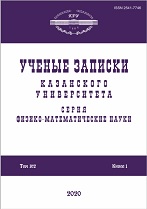|
This article is cited in 3 scientific papers (total in 3 papers)
Estimation of the heterogeneity of the reservoir fluid inflow to the cross-sectional contour of a vertical well
K. A. Potashev, R. R. Akhunov
Kazan Federal University, Kazan, 420008 Russia
Abstract:
The reasons for the heterogeneity of the reservoir fluid inflow to the cross-sectional contour of a vertical well can be: a) asymmetry of the external pressure field relative to the well axis as a result of the interference of the surrounding wells; b) heterogeneity of the permeability field near the well, which is a consequence of either the heterogeneity of the absolute permeability field of the reservoir or the mobility function of the multiphase mixture of formation fluids. To simulate filtration in a reservoir over a relatively long time interval, the main interest is constant or long-term factors associated with well spacing and the distribution of absolute permeability. In the work, solutions of two model problems were constructed, which allow a quantitative evaluation of the influence of both factors on the degree of inhomogeneity of the inflow to the well and indicate the conditions under which this effect becomes significant. The obtained estimates are intended primarily for computational schemes of streamline and streamtube methods, which require a high degree of solution detailing near wells.
Keywords:
oil reservoir, aquifer, vertical well, single-phase flow, well bore cross-section, influx profile, permeability field heterogeneity, wells interference, numerical simulation, fine computational grid, streamline, streamtube.
Received: 12.05.2020
Citation:
K. A. Potashev, R. R. Akhunov, “Estimation of the heterogeneity of the reservoir fluid inflow to the cross-sectional contour of a vertical well”, Uchenye Zapiski Kazanskogo Universiteta. Seriya Fiziko-Matematicheskie Nauki, 162, no. 2, Kazan University, Kazan, 2020, 180–192
Linking options:
https://www.mathnet.ru/eng/uzku1554 https://www.mathnet.ru/eng/uzku/v162/i2/p180
|

|




 Contact us:
Contact us: Terms of Use
Terms of Use
 Registration to the website
Registration to the website Logotypes
Logotypes








 Citation in format
Citation in format 
